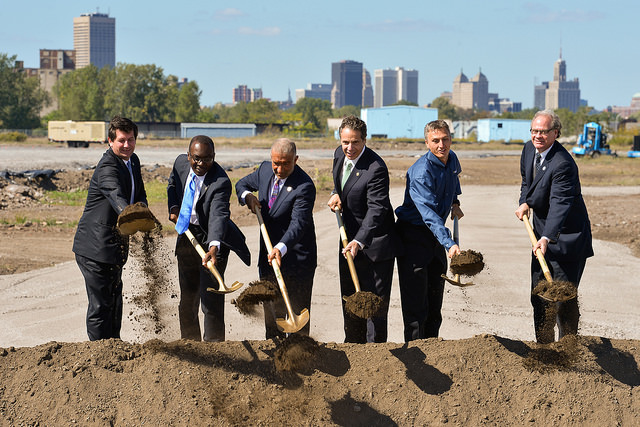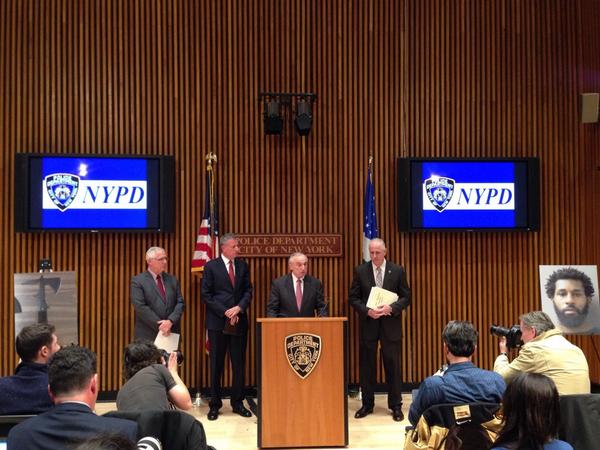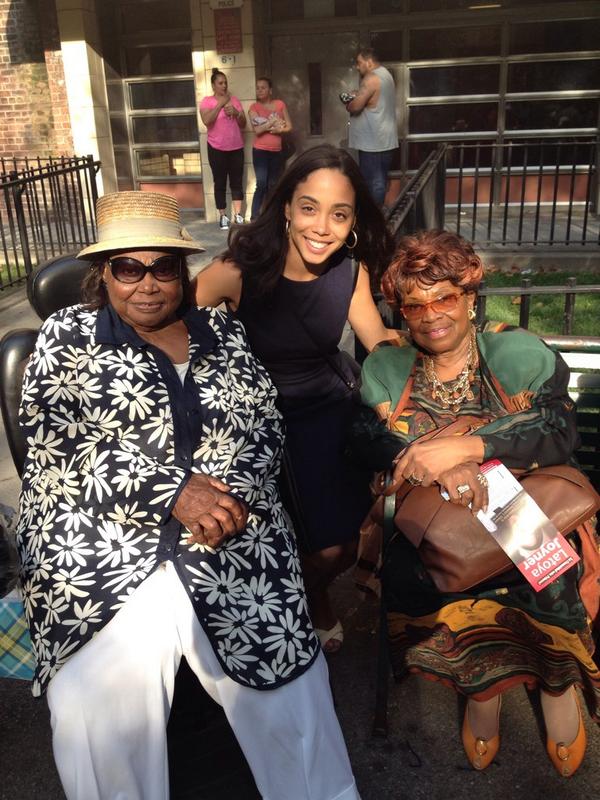Why I'm Voting 'Yes' on the Smart Schools Bond Act, Proposition 3

Gov. Cuomo at an event in Buffalo (photo: Governor's Office via flickr)
There has been much controversy and confusion over the Smart Schools Bond Act, which voters will approve or deny by voting on Tuesday, Election Day. Proposition 3 on the back of ballots, the Smart Schools Bond Act would authorize the sale of bonds to generate $2 billion statewide for capital funding. Each school district can use the revenue in the following ways:
· Purchasing educational technology equipment and facilities, such as interactive whiteboards, computer servers, desktop and laptop computers, tablets and high-speed broadband or wireless internet.
· Constructing and modernizing facilities to accommodate pre-kindergarten programs and replacing classroom trailers with permanent instructional space.
· Installing high-tech security features in school buildings.
While I and many other education advocates including Diane Ravitch are fervently opposed to using any bond revenue for the purchase of devices like laptops or tablets that have a useful lifetime of only a few years, as the interest on the bond act is repaid over twenty or thirty years, it is clear that districts will have the choice of how to use these funds and have a broad array of options.
New York City is due to receive about $780 million if Proposition 3 is approved. The Department of Education's five year capital plan makes it clear that if the bond act passes, $490 million of city funds previously directed toward technology would now be diverted toward building more schools to alleviate overcrowding for smaller classes, creating 4,900 more seats, and the rest toward creating 2,100 seats for pre-kindergarten.
As the analysis in our report Space Crunch makes clear, the city's school capital plan is badly underfunded as is. Though it will includes less than 40,000 additional seats if the Bond Act is approved – and even fewer if it isn't – the real need is at least 100,000 seats, given existing overcrowding and projections of increased enrollment over the next five to ten years.
Moreover, we have thousands of kindergarten children on waiting lists for their zoned school each year, and many thousands more sitting in trailers, temporary structures which are long past their expected lifetime and many leaky and rotting away. While the New York Times reported 7,158 students in trailers, the real figure is likely more than 10,000 students, since the lower number does not include any of the thousands of high school students or many disabled children attending classes in these substandard structures.
I understand the reluctance of parents outside the city who fear wasted funds on computer devices, as in the Los Angeles iPad scandal, which led to the resignation of their superintendent, or the Amplify tablet fiasco in Guilford, North Carolina. Like them, I also oppose the proliferation of online testing and instruction, which is motivated primarily by the desire to eliminate teachers and to benefit data-mining educational technology companies, eager to make a buck off our kids. Class Size Matters successfully led the fight to stop the state's plan to share personal student information with the corporation called inBloom Inc., designed to facilitate the incursion of data-mining vendors in schools, and inBloom closed its doors last spring.
Yet voters elsewhere in the state have elected school boards and should be actively engaged in the decision-making of how to best use the proceeds of the Bond Act. In addition, all parents have the right to opt out of any online data-mining instructional or testing program that collects personal data, whether their children participate in this program at school or home, according to the Children's Online Privacy Protection Act (COPPA). They should exercise that right if they so choose. Class Size Matters and the national coalition we co-chair, the Parent Coalition for Student Privacy, will work to make sure that all parents are informed of their right to do so. We will also continue to fight for the right of children to be able to learn in smaller classes where they receive the personal attention of their teachers in uncrowded schools – and that's why I'm voting for Proposition 3 on Tuesday, and urge others to do the same.
***
Leonie Haimson is the Executive Director of Class Size Matters. Follow her on twitter @leoniehaimson
Report Shows Extent of Racialized Criminalization over last 30 years

PC Bratton gives a briefing (photo: @NYPDNews)
This week's report on the frequency and distribution of misdemeanor arrests from 1980 to today from John Jay College of Criminal Justice provides clear evidence of what many have known for years. The NYPD is engaged in a wide-ranging social experiment in the mass criminalization of poor non-white New Yorkers.
The report shows that misdemeanor arrests have increased from about 60,000 a year in the early 80s to almost 250,000 today. Last year the arrest rate for whites was 1.2 percent, compared to an arrest rate of 6.4 percent for blacks and 4.4 percent for Hispanics.
Misdemeanor arrest rates for all three groups almost doubled from 1990 to 2010. White rates rose from 0.7 percent in 1990 to a high of 1.4 percent in 2011, black rates rose from a low of 3.6 percent in 1990 to a high of 7.5 percent in 2010. Hispanics saw a smaller increase, from 2.5 percent in 1990 to a high of 4.7 percent in 2010.
The bulk of the charges seen in this massive expansion involve low-level drug enforcement, especially of marijuana, prohibitions against commercial sex work, the many disorderly activities associated with living on the streets, and a variety of minor offenses mostly engaged in by young people such as graffiti and riding a bike on the sidewalk.
A shocking 25% of all misdemeanor arrests since 1980 have been for low-level drug violations, including 1 million arrests for marijuana.
The impact on the youngest New Yorkers has been the starkest. 16-17 year olds, who are treated as adults in New York State, saw their rate of arrest jump from 3.2% in 1980 to over 10% in in 2010. That means one in every ten 16-17 year olds was arrested for a misdemeanor in 2010.
Since these arrests are heavily concentrated in communities of color, in some places closer to 3 in every 10 young men in this age group face arrest each year. While that rate has since declined some, we are saddling these young people with permanent arrest records for low level drug involvement, jumping the turnstile, and playground fights in mind numbing numbers. The involvement of police in school safety enforcement has only worsened that trend by criminalizing schoolroom misbehavior as well.
During the 30-year period covered by the report, there has been an explosive increase in poverty and homelessness in New York City, especially among communities of color. African-Americans in particular are poorer and more socially isolated. Our City's response to this profound growth in inequality has been mass criminalization through the War on Drugs and the drive to eliminate "quality of life" problems through heavy-handed zero-tolerance policing, spurred on by a slavish adherence to the unproven "Broken Windows" theory. There is no substantial evidence that this massive expansion in misdemeanor arrests for drug violations, sex work, youthful misbehavior, and the activities associated with living out of doors is responsible for what is an international drop in crime. Hundreds of cities around the world have enjoyed major decreases in crime during this same period without relying on these techniques.
There is, however, clear evidence of the negative consequences of the increased usage of misdemeanor arrests on those arrested and the communities they come from. While disorderly behaviors have been reduced by aggressive policing, it has also torn apart families, destroyed livelihoods, and alienated many from the police, work, and city services.
In addition, the social problems being criminalized by the NYPD have shown no signs of improvement. Unemployment among young men of color remains at very high levels—in some communities topping 50%. Homelessness has increased throughout the period of the report. At the same time, drug use and drug availability remain pervasive, as does access to commercial sex. In other words, life for the poorest New Yorkers remains desperate and their problems are typically compounded by intensive criminalization.
Even if the massive increase in misdemeanor arrests was somehow responsible for a part of the crime decline, the social and financial costs are too high. The high costs of police time, court time, and over $100,000 per bed per year to run the prison on Rikers Island, means the arrest and jailing of people for even short periods is a gross misuse of limited city resources. The intensive criminalization of almost entirely minority populations flies in the face of any effort to reduce inequality, create equal opportunities for all, and improve the real quality of life in minority communities.
We must find lasting solutions to inequality that don't rely on criminalization. Drug use and drug dealing, sex work, and the disorderly behaviors associated with living on the streets are very real social problems, but criminalization at best papers over these problems and in some cases makes the problems and the lives of those involved worse. Resources devoted to criminalization must be repurposed to initiatives designed to create pathways out of homelessness and poverty. We must stop relying on homeless shelters, emergency rooms, and jails to deal with people living on the streets, we must find real economic opportunities for young people of color that take into account the challenges of educational failure, discrimination, and long-term poverty.
We can start with increasing permanent housing with transitional support services for those most in need, a massive expansion in public housing, and reforms to make living conditions better could improve life for hundreds of thousands. We need a major increase in the minimum wage to ensure that those who are working make enough to steer clear from participation in black markets. We need an increase in the standard of living for city employees, who have endured decades of austerity contracts, which has contributed to a thinning out of the middle class in the city, and we need further investment in non-punitive anti-violence initiatives for young people with wraparound services.
Finally we must decriminalize drugs and sex work and address whatever concrete harms are associated with them through community-based initiatives that don't rely on the police, courts, and jails.
The mayor is beginning to pursue some of these strategies, but the needs are huge and resources limited. He should stop wasting precious resources on criminalization and put them where they will do more good than harm.
***
Alex S. Vitale is associate professor of sociology at Brooklyn College and author of City of Disorder: How the Quality of Life Campaign Transformed New York Politics. He is senior policy adviser to hte Police Reform Organizing Project and serves on the New York State Advisory Committee to the US Civil Rights Commission. You can follow him on Twitter: @avitale
The Bronx's Growing Affordable Housing Problem

The author, middle, in the Bronx (photo: @JoinJoyner)
Affordability of housing is a growing problem for Bronx residents and families, more so than any other New York City borough. Having grown up in the area, and now working as a court attorney for a New York City Civil Court Judge, I have seen firsthand the troubles Bronx residents and families are facing. This is one reason I decided to run for the New York State Assembly in the 77th District.
The Institute for Children, Poverty & Homelessness said recently that the Bronx is in dire need of intervention. For instance, the number of homeless families in the Highbridge and Concourse sections increased 37%, to 633 families, from 2005 to 2010. Meanwhile, Bronx median rents increased by 10.5% to $954 per month. And the office of New York City Comptroller Scott Stringer pointed out in April that housing affordability – computed by rent-to-income ratios – decreased for every income group in the city. The hardest hit are those New Yorkers earning less than $40,000 a year. The Bronx median household income is $34,300.
Overall, the 1,084 homeless Bronx families make up the bulk of the city's homeless population, according to a recent Daily News report. And surging rent increases are partly to blame. As an active member of Community Board 4 and the Neighborhood Advisory Board, I know how integral affordable housing is to the lifeblood of this borough. Meanwhile, it's unclear whether current City policies are headed in the right direction. The Rent Guidelines Board voted 5-4 in June to raise rents by 1% for one-year lease agreements for the nearly one million city homes regulated under the stabilization law. If you plan to sign a two-year lease, your rent will rise by 2.75%, according to the board's decision.
But the families protected under these guidelines make up only 45% of all rental units in the City, according to a 2011 New York City housing survey conducted by the Census Bureau.
There may be some light at the end of the tunnel for tenants, however. Mayor Bill de Blasio's laudable "Five-Borough, Ten-Year Plan" to create or protect 200,000 affordable housing units over the next decade is a refreshing source of hope. According to the Community Service Society of New York, the city lost about 385,000 units of affordable housing between 2002 and 2011.
More than ever before, housing and rent regulations need a tune-up to address the current and future needs of Bronxites. With rent regulations up for renewal in Albany in June 2015, I will advocate to strengthen existing laws that will preserve and protect affordable apartments.
***
by Latoya Joyner, Democratic candidate for State Assembly in the 77th Assembly District. Find her on Twitter.
***
Note: publishing this op-ed is in no way an endorsement of Ms. Joyner's candidacy. Any candidate for office is welcome to submit a substantive op-ed to our editorial desk.
On the November ballot, Ms. Joyner, a Democrat, is opposed by Republican Esparanza Reyes Acosta and Conservative Party nominee Benjamin Eggleston.




